Midweek Review
Training actors through Angampora:
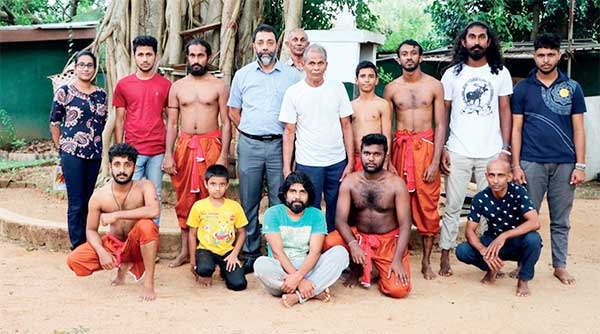
Guru Karunapala and his angampora team at Sri Jayawardhanapura University, Gangodavila, Nugedoda. Photo credits Saumya Liyanage 2020.
A project to seek alternative paradigm at UVPA Colombo
By Saumya Liyanage | Lyudmyla Honcharova | Banduka Premawardhana
The concept of ‘actor training’ or ‘performer training’ has developed through the modern era of theatre and dance pedagogies. Western actor training traditions started with the influence of master actor trainer and theoretician Konstantin Stanislavski. As early as the beginning of the 19th century, Stanislavski started his theatrical exploration at his main laboratory known as the Moscow Arts Theatre (MAT) in Russia. His lifelong quest for actors’ arts and his passion for finding a methodology to develop an actor training system continued at the MAT theatre. However, Stanislavski’s actor training system is the most misinterpreted performer training system used in Europe, America, and Asia. As Alison Hodge argues, Stanislavski’s exploration of actors’ arts was more into actors’ inner and outer faculties and further discusses how this interior and exterior interact with each other (Hodge, 2010). Although Stanislavski’s teaching has been variously interpreted and adapted for diverse purposes to train actors, his influence in the modern theatre is still influential in theatre and performance studies (Liyanage 2016).
As Sharon Carnicke believes that Stanislavski wanted his actors to train their ‘selves’ to develop the rounded and full-fledged characters they portray (Sharon Marie Carnicke, 2009). For instance, Stanislavski’s early psychological approaches were influenced by French psychology, and he was continuing his exploration to cater to the emergence of the symbolism and naturalism introduced by the theatre texts of Ibsen, Gorki, Chekov, and others. The need of developing systematic ways to train actors was not an abrupt action that emerged at the MAT Theatre but a purposeful intervention to absorb the modern theatre tradition and the naturalistic dramatic texts that were germinating in early 19th century Europe.
Intercultural performer training
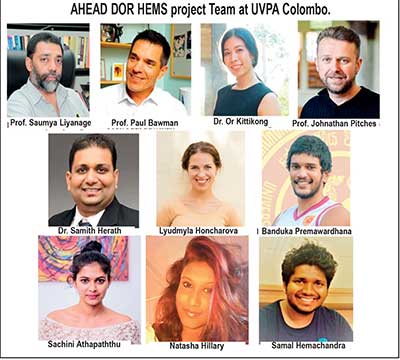 It is inevitable that Western actor training has been heavily influenced by Eastern performance traditions. From the father of modern acting, Konstantin Stanislavski, to Bertolt Brecht in Germany, Jerzy Grotowski in Poland, and Antonin Artaud in France, Western actor training has been directly or indirectly influenced by one or more Asian performer training paradigms such as hatha yoga, Balinese dance, or Indian dance dramas such as kathakali and kuttiyattam. Theatre historians have observed that at the MAT, Stanislavski was preparing to produce a Sanskrit play and conducting hatha yoga practices through an Indian yoga master. Further, it is widely discussed that Bertolt Brecht encountered Peking Opera actor Mei Lanfang during his visit to Russia (Tian, 1997, Brecht & Bentley, 1961).
It is inevitable that Western actor training has been heavily influenced by Eastern performance traditions. From the father of modern acting, Konstantin Stanislavski, to Bertolt Brecht in Germany, Jerzy Grotowski in Poland, and Antonin Artaud in France, Western actor training has been directly or indirectly influenced by one or more Asian performer training paradigms such as hatha yoga, Balinese dance, or Indian dance dramas such as kathakali and kuttiyattam. Theatre historians have observed that at the MAT, Stanislavski was preparing to produce a Sanskrit play and conducting hatha yoga practices through an Indian yoga master. Further, it is widely discussed that Bertolt Brecht encountered Peking Opera actor Mei Lanfang during his visit to Russia (Tian, 1997, Brecht & Bentley, 1961).
In the late 19th century, theatre practitioners such as Eugenio Barba, John Littlewood, Peter Brook, and Mnouchkine borrowed intercultural performance elements from Asian traditions. However, borrowing and assimilating cultural elements from an alien culture posed several problems. Some critics have questioned the ways that the European avant-garde were looking at cultural ‘others’ in the peripheral world. They argued that the modernist theatre directors’ ideology behind cultural appropriation was constructed within the binaries of ‘culture and savage’ (Gale et al., 2016). Alison Hodge also argues that ‘Asian actor training traditions run the risk of being exoticised or simplistically appropriated by practitioners in the West’ (Hodge, 2010, p. xxi). Jerzy Grotowski has argued that Asian performance traditions are not to be directly used to codify actors’ bodies (Jerzy Grotowski et al., 2015). Rustom Bharucha has extensively discussed the misappropriation, misinterpretations, and mythologisation of Indian dramatic heritage by Western theatre practitioners such as Brook, Schechner and others (Bharucha 1984, P. 2-3).
Angampora
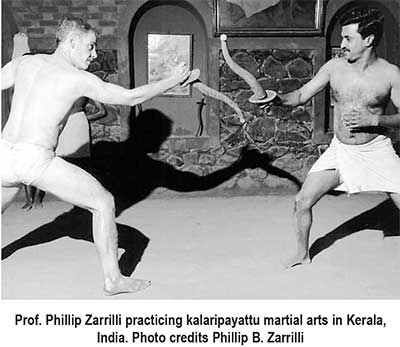 The project, which seeks to develop an actor training system through the Sri Lankan combative art, angampora, also bears such cultural complexities when adapting and assimilating a martial arts practice that has been passed down to generations of practitioners through guru-shishya-parampara model. There are many angampora groups and schools in the country and each group has its own ways of tracing their historical affiliations to myths and legends that explore various avenues and genealogies of angampora. Many believe that it was introduced by the Yakkha tribe. In more recent history, the ten warrior giants of King Dutugemunu were the first recorded practitioners of Illangam Satan (the use of weaponry in combat), each having specialised in a unique weapon, and technique.
The project, which seeks to develop an actor training system through the Sri Lankan combative art, angampora, also bears such cultural complexities when adapting and assimilating a martial arts practice that has been passed down to generations of practitioners through guru-shishya-parampara model. There are many angampora groups and schools in the country and each group has its own ways of tracing their historical affiliations to myths and legends that explore various avenues and genealogies of angampora. Many believe that it was introduced by the Yakkha tribe. In more recent history, the ten warrior giants of King Dutugemunu were the first recorded practitioners of Illangam Satan (the use of weaponry in combat), each having specialised in a unique weapon, and technique.
The advances of the Portuguese were resisted by fighters such as King Rajasinghe, the Battle of Mulleriyawa being one such instance. The Kandyan Kingdom resisted the colonizers with the use of angam fighting strategies and techniques. Eventually, the combative art form that received royal patronage through time became the first martial art in the world to be prohibited; the British banned it in 1818 under the governance of Robert Brownrigg.
Suspect practitioners were shot below the knee, while confirmed angampora martial artistes were put to death. angampora was hidden away in various dance forms such as the koti netuma, and more popular styles such as udarata and pahatharata schools of dance. Following Independence, angampora has resurfaced and is becoming popular in Sri Lanka.
Actor Training and Martial Arts
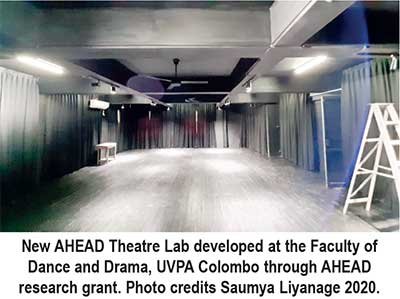 It might seem that actor training and martial arts are disciplines that have nothing in common. However, this assumption is wrong. Obviously, both are forms of art which share similar approaches. In many martial arts performances, one can observe that performing elements such as fighters’ presentations and demonstrations of fighting skills is accompanied with music. In line with this, theatre performance can also be considered the demonstration of an actor’s skills since the actor shows his/her body-mind integration during performance which are gained in a process of training. It is observed that body-mind integration is a common feature in both arts. Therefore, it is clear that martial arts practitioners and actors are experts of the body. ‘In most drama schools of European traditions, actors are trained to use their bodies (Barrault cited in Bloch, p. 220).
It might seem that actor training and martial arts are disciplines that have nothing in common. However, this assumption is wrong. Obviously, both are forms of art which share similar approaches. In many martial arts performances, one can observe that performing elements such as fighters’ presentations and demonstrations of fighting skills is accompanied with music. In line with this, theatre performance can also be considered the demonstration of an actor’s skills since the actor shows his/her body-mind integration during performance which are gained in a process of training. It is observed that body-mind integration is a common feature in both arts. Therefore, it is clear that martial arts practitioners and actors are experts of the body. ‘In most drama schools of European traditions, actors are trained to use their bodies (Barrault cited in Bloch, p. 220).
It should be noted that martial arts methodologies are comparatively older and have more defined training structure than actor training. Since first actor training systems evolved in the end of the 19th century in the West, it is not surprising that theatre practitioners were using martial art principles during the creation of their actor training methodologies. Such practitioners were Scott, Copeau, Zarilli, Suzuki, and others. For instance, ‘Scott used tai ji quan as an actor training discipline, was not only a rejection of American actors’ exclusive attention to a psychologically/behaviorally based paradigm of acting, but also an attempt to actualize an alternative paradigm’ (Zarrilli 1995, p. 185). They were paying attention to techniques that strive to develop presence, awareness, and a holistic approach to body-mind work in acting. Many of these actor trainers have referred to Asian martial arts styles.
AHEAD Project 2019-2021
In 2019, Prof. Saumya Liyanage and research assistant to the Faculty of Graduate Studies (FGS) University of Visual and Performing Arts (UVPA) Mr Samal Vimukthi Hemachandra submitted a research proposal titled, ‘Lamp in a windless place: developing an actor training methodology through Sri Lankan martial art’. This research proposal won a competitive grant of Rs. 10 million from the Accelerating Higher Education Expansion and Development (AHEAD) project to pursue a three-year-long actor training exploration. The project was initially influenced by the works of the late Phillip B. Zarrilli, Professor of performance practice and well-known theatre scholar at Exeter University, UK. His research on kalaripayattu martial arts in Kerala India and his years of first-hand experience with kalaripayattu martial arts, kathakali and kuttiyattam dance dramas in India had allowed him to formulate an intercultural actor training system derived mainly from kalaripayattu martial arts in Kerala.
Project Team at UVPA Colombo
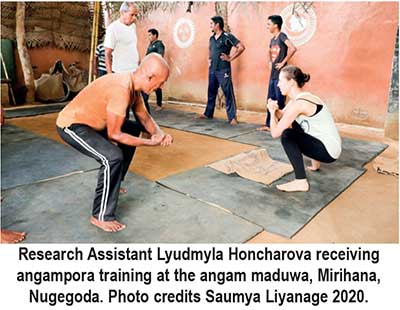 Prof. Paul Bowman and Prof. Jonathan Pitches are authorities on martial arts studies and performer training in the world and both professors work as foreign consultants to this actor training project. Prof. Bowman is working at Cardiff University, UK and he has written much about martial arts practice. His latest book is Deconstructing Martial Arts published by Cardiff University Press in 2019. Prof. Jonathan Pitches is a professor of theatre and performance at the University of Leeds and has published many leading academic texts on theatre and actor training. His latest publication is Performing Mountains published by Palgrave McMillan in 2020.
Prof. Paul Bowman and Prof. Jonathan Pitches are authorities on martial arts studies and performer training in the world and both professors work as foreign consultants to this actor training project. Prof. Bowman is working at Cardiff University, UK and he has written much about martial arts practice. His latest book is Deconstructing Martial Arts published by Cardiff University Press in 2019. Prof. Jonathan Pitches is a professor of theatre and performance at the University of Leeds and has published many leading academic texts on theatre and actor training. His latest publication is Performing Mountains published by Palgrave McMillan in 2020.
Prof. Saumya Liyanage works as the coordinator of the project and its chief investigator. Dr Samith Herath from the Faculty of Visual Arts is the deputy coordinator of the project. His expertise in virtual reality applications and biofeedback technology also help project researchers to capture and monitor actors’ movement works and their biofeedback impulses through cutting edge technology. Natasha Hillary and Sachini Athapaththu work as admin assistants of the project.
In the initial stages of this project, the research team explored the traditional practice of angampora of Guru Karunapala, an 80-year-old angampora master, at his angampora maduwa located in Mirihana, Nugegoda. The field research and embodied practice of angampora are conducted and his legacy of angampora martial arts and indigenous corporeal practices are further explored. Research assistant Lyudmyla Honcharowa explores angampora martial arts with Guru Karunapala while investigating indigenous healing practices of body and mind. Lyudmyla Honcharowa is an actor from Ukraine reading for her MPhil research degree under Prof. Saumya Liyanage’s supervision to explore the connections of actor training methodologies in Europe and Asia. Banduka Premawardhana. also a research assistant of this project, is also reading for his MPhil degree under Prof. Liyanage. He explores how a traditional martial art like angampora could facilitate the training of actors for film and digital medium.
The second phase of the project will start with establishing an actor training laboratory at the Faculty of Dance and Drama, UVPA Colombo. The AHEAD grant supported in renovating an existing rehearsal room into a fully equipped studio space. At the first stage, a group of actors will go through angampora training under supervision of Guru Karunapala to understand and embody angampora principles. During the second phase of laboratory work, actors will be introduced to methods that will be an amalgamation of acting methodologies and angampora martial arts. All stages of actors’ laboratory work are going to be video recorded. Further, actors will be writing personal journals with reflection on the training process which will serve as a source of material for developing a new actor training methodology. In the last stage of the project, a workshop demonstration will be created and performed in front of a selected audience to evaluate the impact of actors and their engagement with the audience. As a part of the project, several angampora groups are chosen for field visits around the country. Project members will also be presenting papers and sharing their findings at international conferences during the project.
Conclusion
The COVID-19 pandemic has adversely affected the activities designed for this actor training project in 2020. The project team was planning to conduct a six-month-long actor training laboratory at the newly renovated studio located at the Faculty of Dance and Drama. However, due to the pandemic situation, these actor training activities have not been able to proceed. In 2021, and with institutional support, the project team is looking forward to launch their laboratory actor training sessions.
UVPA Vice Chancellor Senior Professor Rohana Mahaliyanaarachchi and his office, the Dean of the Faculty of Dance and Drama, Dr Indika Ferdinando and the OTS office director Dr Anusha Jayasiri and her team have extended their fullest support for the project, which is the first actor training project initiated in a State University in Sri Lanka. This project further intends to work with the University Business Linkage (UBL) office and the Director of UBL, Dr Priyeshni Peiris to seek a business model to use this methodology in the creative industry in Sri Lanka and beyond.
Acknowledgements
Authors of this paper wish to thank Himansi Dehigama and Sachini Senevirathne for proof-reading this paper.
About authors: Prof. Saumya Liyanage is a well-known actor and an academic currently working at the Faculty of Dance and Drama, University of the Visual and Performing Arts, Colombo. Lyudmyla Honcharova and Banduka Premawardhana are both working as research assistants to AHEAD DOR HEMS actor training project and they are reading two MPhil degrees exploring martial arts and actor training under the AHEAD grant scheme.
References
Bharucha, R. (1984). A Collision of Cultures: Some Western Interpretations of the Indian Theatre. Asian Theatre Journal, 1(1), 1. https://doi.org/10.2307/1124363
Brecht, B., & Bentley, E. (1961). On Chinese Acting. The Tulane Drama Review, 6(1), 130. https://doi.org/10.2307/1125011
Gale, M. B., Deeney, J. F., Rebellato, D., & Lavery, C. (2016). The Routledge drama anthology and sourcebook : from modernism to contemporary performance. Routledge.
Hodge, A. (2010). Actor training. Routledge.
Jerzy Grotowski, Barba, E., & Brook, P. (2015). Towards a poor theatre. Bloomsbury Methuen Drama.
Ministry of Higher Education, A. O. (2020). Accelerating Higher Education Expansion and Development (AHEAD). https://ahead.lk/
Saumya Liyanage. (2016). Meditations on acting : essays on theory, practice and performance. Dev Publishing.
Sharon Marie Carnicke. (2009). Stanislavsky in focus : an acting master for the 21st century. Routledge.
Tian, M. (1997). “Alienation-Effect” for Whom? Brecht’s (Mis)interpretation of the Classical Chinese Theatre. Asian Theatre Journal, 14(2), 200. https://doi.org/10.2307/1124277
Zarrilli, P. B. (2002). Acting (re)considered : a theoretical and practical guide. Routledge.
Zarrilli, P. B., T Sasitharan, & Anuradha Kapur. (2019). Intercultural acting and performer training. Routledge.
- News Advertiesment
See Kapruka’s top selling online shopping categories such as Toys, Grocery, Flowers, Birthday Cakes, Fruits, Chocolates, Clothing and Electronics. Also see Kapruka’s unique online services such as Money Remittence,News, Courier/Delivery, Food Delivery and over 700 top brands. Also get products from Amazon & Ebay via Kapruka Gloabal Shop into Sri Lanka.
Midweek Review
‘Professor of English Language Teaching’
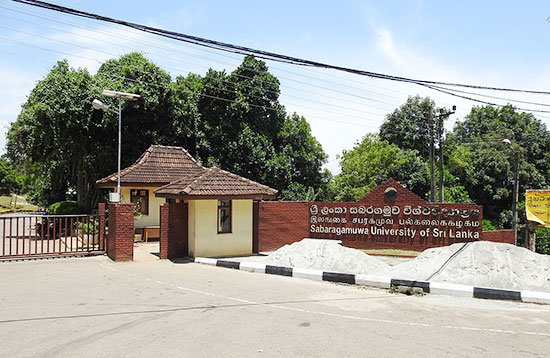
It is a pleasure to be here today, when the University resumes postgraduate work in English and Education which we first embarked on over 20 years ago. The presence of a Professor on English Language Teaching from Kelaniya makes clear that the concept has now been mainstreamed, which is a cause for great satisfaction.
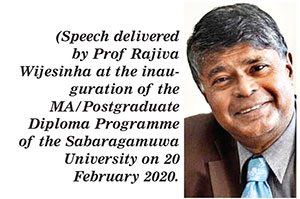 Twenty years ago, this was not the case. Our initiative was looked at askance, as indeed was the initiative which Prof. Arjuna Aluwihare engaged in as UGC Chairman to make degrees in English more widely available. Those were the days in which the three established Departments of English in the University system, at Peradeniya and Kelaniya and Colombo, were unbelievably conservative. Their contempt for his efforts made him turn to Sri Jayewardenepura, which did not even have a Department of English then and only offered it as one amongst three subjects for a General Degree.
Twenty years ago, this was not the case. Our initiative was looked at askance, as indeed was the initiative which Prof. Arjuna Aluwihare engaged in as UGC Chairman to make degrees in English more widely available. Those were the days in which the three established Departments of English in the University system, at Peradeniya and Kelaniya and Colombo, were unbelievably conservative. Their contempt for his efforts made him turn to Sri Jayewardenepura, which did not even have a Department of English then and only offered it as one amongst three subjects for a General Degree.
Ironically, the most dogmatic defence of this exclusivity came from Colombo, where the pioneer in English teaching had been Prof. Chitra Wickramasuriya, whose expertise was, in fact, in English teaching. But her successor, when I tried to suggest reforms, told me proudly that their graduates could go on to do postgraduate degrees at Cambridge. I suppose that, for generations brought up on idolization of E. F. C. Ludowyke, that was the acme of intellectual achievement.
I should note that the sort of idealization of Ludowyke, the then academic establishment engaged in was unfair to a very broadminded man. It was the Kelaniya establishment that claimed that he ‘maintained high standards, but was rarefied and Eurocentric and had an inhibiting effect on creative writing’. This was quite preposterous coming from someone who removed all Sri Lankan and other post-colonial writing from an Advanced Level English syllabus. That syllabus, I should mention, began with Jacobean poetry about the cherry-cheeked charms of Englishwomen. And such a characterization of Ludowyke totally ignored his roots in Sri Lanka, his work in drama which helped Sarachchandra so much, and his writing including ‘Those Long Afternoons’, which I am delighted that a former Sabaragamuwa student, C K Jayanetti, hopes to resurrect.
I have gone at some length into the situation in the nineties because I notice that your syllabus includes in the very first semester study of ‘Paradigms in Sri Lankan English Education’. This is an excellent idea, something which we did not have in our long-ago syllabus. But that was perhaps understandable since there was little to study then except a history of increasing exclusivity, and a betrayal of the excuse for getting the additional funding those English Departments received. They claimed to be developing teachers of English for the nation; complete nonsense, since those who were knowledgeable about cherries ripening in a face were not likely to move to rural areas in Sri Lanka to teach English. It was left to the products of Aluwihare’s initiative to undertake that task.
Another absurdity of that period, which seems so far away now, was resistance to training for teaching within the university system. When I restarted English medium education in the state system in Sri Lanka, in 2001, and realized what an uphill struggle it was to find competent teachers, I wrote to all the universities asking that they introduce modules in teacher training. I met condign refusal from all except, I should note with continuing gratitude, from the University of Sri Jayewardenepura, where Paru Nagasunderam introduced it for the external degree. When I started that degree, I had taken a leaf out of Kelaniya’s book and, in addition to English Literature and English Language, taught as two separate subjects given the language development needs of students, made the third subject Classics. But in time I realized that was not at all useful. Thankfully, that left a hole which ELT filled admirably at the turn of the century.
The title of your keynote speaker today, Professor of English Language Teaching, is clear evidence of how far we have come from those distant days, and how thankful we should be that a new generation of practical academics such as her and Dinali Fernando at Kelaniya, Chitra Jayatilleke and Madhubhashini Ratnayake at USJP and the lively lot at the Postgraduate Institute of English at the Open University are now making the running. I hope Sabaragamuwa under its current team will once again take its former place at the forefront of innovation.
To get back to your curriculum, I have been asked to teach for the paper on Advanced Reading and Writing in English. I worried about this at first since it is a very long time since I have taught, and I feel the old energy and enthusiasm are rapidly fading. But having seen the care with which the syllabus has been designed, I thought I should try to revive my flagging capabilities.
However, I have suggested that the university prescribe a textbook for this course since I think it is essential, if the rounded reading prescribed is to be done, that students should have ready access to a range of material. One of the reasons I began while at the British Council an intensive programme of publications was that students did not read round their texts. If a novel was prescribed, they read that novel and nothing more. If particular poems were prescribed, they read those poems and nothing more. This was especially damaging in the latter case since the more one read of any poet the more one understood what he was expressing.
Though given the short notice I could not prepare anything, I remembered a series of school textbooks I had been asked to prepare about 15 years ago by International Book House for what were termed international schools offering the local syllabus in the English medium. Obviously, the appalling textbooks produced by the Ministry of Education in those days for the rather primitive English syllabus were unsuitable for students with more advanced English. So, I put together more sophisticated readers which proved popular. I was heartened too by a very positive review of these by Dinali Fernando, now at Kelaniya, whose approach to students has always been both sympathetic and practical.
I hope then that, in addition to the texts from the book that I will discuss, students will read other texts in the book. In addition to poetry and fiction the book has texts on politics and history and law and international relations, about which one would hope postgraduate students would want some basic understanding.
Similarly, I do hope whoever teaches about Paradigms in English Education will prescribe a textbook so that students will understand more about what has been going on. Unfortunately, there has been little published about this but at least some students will I think benefit from my book on English and Education: In Search of Equity and Excellence? which Godage & Bros brought out in 2016. And then there was Lakmahal Justified: Taking English to the People, which came out in 2018, though that covers other topics too and only particular chapters will be relevant.
The former book is bulky but I believe it is entertaining as well. So, to conclude I will quote from it, to show what should not be done in Education and English. For instance, it is heartening that you are concerned with ‘social integration, co-existence and intercultural harmony’ and that you want to encourage ‘sensitivity towards different cultural and linguistic identities’. But for heaven’s sake do not do it as the NIE did several years ago in exaggerating differences. In those dark days, they produced textbooks which declared that ‘Muslims are better known as heavy eaters and have introduced many tasty dishes to the country. Watalappam and Buriani are some of these dishes. A distinguished feature of the Muslims is that they sit on the floor and eat food from a single plate to show their brotherhood. They eat string hoppers and hoppers for breakfast. They have rice and curry for lunch and dinner.’ The Sinhalese have ‘three hearty meals a day’ and ‘The ladies wear the saree with a difference and it is called the Kandyan saree’. Conversely, the Tamils ‘who live mainly in the northern and eastern provinces … speak the Tamil language with a heavy accent’ and ‘are a close-knit group with a heavy cultural background’’.
And for heaven’s sake do not train teachers by telling them that ‘Still the traditional ‘Transmission’ and the ‘Transaction’ roles are prevalent in the classroom. Due to the adverse standard of the school leavers, it has become necessary to develop the learning-teaching process. In the ‘Transmission’ role, the student is considered as someone who does not know anything and the teacher transmits knowledge to him or her. This inhibits the development of the student.
In the ‘Transaction’ role, the dialogue that the teacher starts with the students is the initial stage of this (whatever this might be). Thereafter, from the teacher to the class and from the class to the teacher, ideas flow and interaction between student-student too starts afterwards and turns into a dialogue. From known to unknown, simple to complex are initiated and for this to happen, the teacher starts questioning.’
And while avoiding such tedious jargon, please make sure their command of the language is better than to produce sentences such as these, or what was seen in an English text, again thankfully several years ago:
Read the story …
Hello! We are going to the zoo. “Do you like to join us” asked Sylvia. “Sorry, I can’t I’m going to the library now. Anyway, have a nice time” bye.
So Syliva went to the zoo with her parents. At the entrance her father bought tickets. First, they went to see the monkeys
She looked at a monkey. It made a funny face and started swinging Sylvia shouted: “He is swinging look now it is hanging from its tail its marvellous”
“Monkey usually do that’
I do hope your students will not hang from their tails as these monkeys do.
Midweek Review
Little known composers of classical super-hits
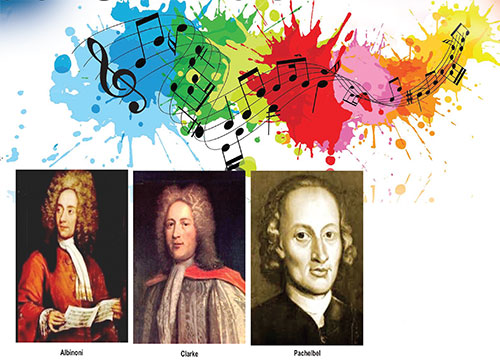
By Satyajith Andradi
Quite understandably, the world of classical music is dominated by the brand images of great composers. It is their compositions that we very often hear. Further, it is their life histories that we get to know. In fact, loads of information associated with great names starting with Beethoven, Bach and Mozart has become second nature to classical music aficionados. The classical music industry, comprising impresarios, music publishers, record companies, broadcasters, critics, and scholars, not to mention composers and performers, is largely responsible for this. However, it so happens that classical music lovers are from time to time pleasantly struck by the irresistible charm and beauty of classical pieces, the origins of which are little known, if not through and through obscure. Intriguingly, most of these musical gems happen to be classical super – hits. This article attempts to present some of these famous pieces and their little-known composers.
Pachelbel’s Canon in D
The highly popular piece known as Pachelbel’s Canon in D constitutes the first part of Johann Pachelbel’s ‘Canon and Gigue in D major for three violins and basso continuo’. The second part of the work, namely the gigue, is rarely performed. Pachelbel was a German organist and composer. He was born in Nuremburg in 1653, and was held in high esteem during his life time. He held many important musical posts including that of organist of the famed St Stephen’s Cathedral in Vienna. He was the teacher of Bach’s elder brother Johann Christoph. Bach held Pachelbel in high regard, and used his compositions as models during his formative years as a composer. Pachelbel died in Nuremburg in 1706.
Pachelbel’s Canon in D is an intricate piece of contrapuntal music. The melodic phrases played by one voice are strictly imitated by the other voices. Whilst the basso continuo constitutes a basso ostinato, the other three voices subject the original tune to tasteful variation. Although the canon was written for three violins and continuo, its immense popularity has resulted in the adoption of the piece to numerous other combinations of instruments. The music is intensely soothing and uplifting. Understandingly, it is widely played at joyous functions such as weddings.
Jeremiah Clarke’s Trumpet Voluntary
The hugely popular piece known as ‘Jeremiah Clarke’s Trumpet Voluntary’ appeared originally as ‘ The Prince of Denmark’s March’ in Jeremiah Clarke’s book ‘ Choice lessons for the Harpsichord and Spinet’, which was published in 1700 ( Michael Kennedy; Oxford Dictionary of Music ). Sometimes, it has also been erroneously attributed to England’s greatest composer Henry Purcell (1659 – 1695 ) and called ‘Purcell’s Trumpet Voluntary (Percy A. Scholes ; Oxford Companion to Music). This brilliant composition is often played at joyous occasions such as weddings and graduation ceremonies. Needless to say, it is a piece of processional music, par excellence. As its name suggests, it is probably best suited for solo trumpet and organ. However, it is often played for different combinations of instruments, with or without solo trumpet. It was composed by the English composer and organist Jeremiah Clarke.
Jeremiah Clarke was born in London in 1670. He was, like his elder contemporary Pachelbel, a musician of great repute during his time, and held important musical posts. He was the organist of London’s St. Paul’s Cathedral and the composer of the Theatre Royal. He died in London in 1707 due to self – inflicted gun – shot injuries, supposedly resulting from a failed love affair.
Albinoni’s Adagio
The full title of the hugely famous piece known as ‘Albinoni’s Adagio’ is ‘Adagio for organ and strings in G minor’. However, due to its enormous popularity, the piece has been arranged for numerous combinations of instruments. It is also rendered as an organ solo. The composition, which epitomizes pathos, is structured as a chaconne with a brooding bass, which reminds of the inevitability and ever presence of death. Nonetheless, there is no trace of despondency in this ethereal music. On the contrary, its intense euphony transcends the feeling of death and calms the soul. The composition has been attributed to the Italian composer Tomaso Albinoni (1671 – 1750), who was a contemporary of Bach and Handel. However, the authorship of the work is shrouded in mystery. Michael Kennedy notes: “The popular Adagio for organ and strings in G minor owes very little to Albinoni, having been constructed from a MS fragment by the twentieth century Italian musicologist Remo Giazotto, whose copyright it is” (Michael Kennedy; Oxford Dictionary of Music).
Boccherini’s Minuet
The classical super-hit known as ‘Boccherini’s Minuet’ is quite different from ‘Albinoni’s Adagio’. It is a short piece of absolutely delightful music. It was composed by the Italian cellist and composer Luigi Boccherini. It belongs to his string quintet in E major, Op. 13, No. 5. However, due to its immense popularity, the minuet is performed on different combinations of instruments.
Boccherini was born in Lucca in 1743. He was a contemporary of Haydn and Mozart, and an elder contemporary of Beethoven. He was a prolific composer. His music shows considerable affinity to that of Haydn. He lived in Madrid for a considerable part of his life, and was attached to the royal court of Spain as a chamber composer. Boccherini died in poverty in Madrid in 1805.
Like numerous other souls, I have found immense joy by listening to popular classical pieces like Pachelbel’s Canon in D, Jeremiah Clarke’s Trumpet Voluntary, Albinoni’s Adagio and Boccherini’s Minuet. They have often helped me to unwind and get over the stresses of daily life. Intriguingly, such music has also made me wonder how our world would have been if the likes of Bach, Handel, Haydn, Mozart, Beethoven, and Schubert had never lived. Surely, the world would have been immeasurably poorer without them. However, in all probability, we would have still had Pachelbel’s Canon in D, Jeremiah Clarke’s Trumpet Voluntary, Albinoni’s Adagio, and Boccherini’s Minuet, to cheer us up and uplift our spirits.
Midweek Review
The Tax Payer and the Tough
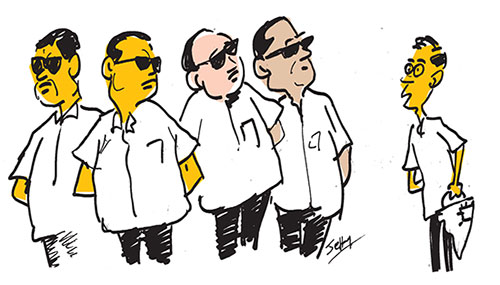
By Lynn Ockersz
The tax owed by him to Caesar,
Leaves our retiree aghast…
How is he to foot this bill,
With the few rupees,
He has scraped together over the months,
In a shrinking savings account,
While the fires in his crumbling hearth,
Come to a sputtering halt?
But in the suave villa next door,
Stands a hulk in shiny black and white,
Over a Member of the August House,
Keeping an eagle eye,
Lest the Rep of great renown,
Be besieged by petitioners,
Crying out for respite,
From worries in a hand-to-mouth life,
But this thought our retiree horrifies:
Aren’t his hard-earned rupees,
Merely fattening Caesar and his cohorts?









